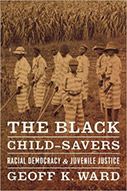The Black Child-Savers: Racial Democracy and Juvenile Justice
 Author: Geoff K. Ward
Author: Geoff K. Ward
Publisher: Chicago: University of Chicago Press, 2012. 344p.
Reviewer: Barry Krisberg | July 2013
This magnificent historical study fills a much needed gap in the socio-legal evolution of the American Juvenile Court. Until very recently, most of the scholarship on the rise of juvenile justice was centered on the treatment of European immigrants in Northern and Central cities. Professor Ward directs the reader to consider the plight of African American youth during most of the 19th and 20th centuries. He demonstrates that the methods of social control and the role of humanitarian philosophy had little to do with how the nation treated slave children and their ancestors. Another recent book by Miraslava Chavez-Garcia augments this multi-ethnic history by examining the treatment of Native American, Latino and Asian youths in California. Both studies illustrate the commitment and resolve of community members to redeem vulnerable children from their own ethnic groups.
Professor Ward describes the brutal treatment of African Americans under slavery and during the early years after the Civil War. White Americans did not consider African children as humans and therefore had little or no interest in dealing with them except as chattel. After Emancipation, the South erected a variety of legal fictions to re-enslave Black Americans using the criminal justice system. It is worth recalling that the 13th Amendment of the United States Constitution abolished slavery except as a punishment for crime.
Massive numbers of former slaves were arrested and charged with trumped up felonies. This permitted their former masters to continue to exploit the economic value of their labor in prison work camps and via the brutal and corrupt convict lease system. Whites made no allowances for the vulnerability of children in these settings.
In the North and Midwest, cities and states created houses of refuge and reformatories for wayward White youth; these facilities generally prohibited holding Black youth together with the European youth. African American youth continued to be sent to adult jails and workhouses, or in some cases were confined in racially segregated places for juveniles. The emergence of community alternatives for delinquent youth such as apprenticeships or probation were usually not available for youth of color. The racially segregated youth facilities that did exist were inferior in every way from the White facilities. Most of the well known Child-Savers who created the America juvenile justice system did not believe that Black youth had the capacity to become productive and law abiding American citizens.
First in the South and then in other parts of the country, members of communities of color worked to rescue the children of their communities from these horrible conditions. The initial engine of reform was women’s clubs in the African American community who raised resources and lobbied to create the first facilities for Black children. Unlike their better healed White counterparts, these Black women’s groups were not wealthy or politically connected. They were mostly unable to influence the political process. Instead they worked with local segregated churches and staffed these programs themselves as teachers and caretakers. These courageous women knew that saving their troubled and wayward children was critical to the future of their communities — a lesson that needs to be learned again today.
The early Black Child-Savers were close to those who helped create the very first colleges and technical schools such as Tuskegee and Hampton. Their mission was to promote a spirit of community self-help and to give youth basic economic survival skills. This was no time to directly challenge the violent regime of Jim Crow with its reality of lynching, daily violent attacks and race riots targeted at Blacks and legal prohibitions against racial integration in almost all aspects of civil and political life.
This book is very much a short course in African American political thought and action. Some of the most important thinkers and activists in the quest for racial justice are part of Ward’s analysis. We learn of the important contributions of Booker T. Washington, Marcus Garvey, W.E.B DuBois, and later William Patterson, Thurgood Marshall, A. Phillip Randolph and Benjamin Mays in the pursuit of justice for Black youth.
Professor Ward moves the narrative through the pivotal decades of the 20th century, ending the narrative in contemporary times. He recounts the intellectual contributions of Kenneth Clark and Charles S. Johnson in building meaningful legal and social responses to at-risk youth of color.
There are compelling data showing that the over-representation of youth of color in confinement has gotten worse not better over many decades. Even as fewer White youth were locked up in prisons and jails, these tragic numbers worsened for Black youth. My own research found that efforts to deinstitutionalize youth mostly reduced the incarceration of White youth, whereas campaigns to toughen laws and increase penalties in the justice system fell primarily on youth of color.
There are a few serious omissions in Ward’s historical panorama. He says very little about the extraordinary movement to close juvenile training schools – started first in Massachusetts by Jerome Miller and later generalized to over 40 states. The reader should know more about how racial politics and communities of color figured into these reforms. Alternatively, Ward pays insufficient attention to the academic conservatives such as James Q. Wilson, Charles Murray and John Dilulio who manufactured a new rationale for oppressing Black youth based on bogus claims of their inferior intelligence, alleged defective emotional capacity and familial desperation. These influential scholars convinced policy makers that America was about to the overrun by a generation of “super predators” who would create a “Crime Bomb. This led to increased incarceration of Black and Brown youth and the rush to prosecute more children in criminal courts. Another key social trend that requires more attention is the extremely adverse impact of the War on Drugs on youth of color, including the hysteria over “crack babies” who were falsely alleged to suffer permanent neurological damage. And the media-fed moral panic over gangs in Black communities that contributed to zero tolerance policies kicking youngsters out of school and bringing police into the classroom on a routine basis. Perhaps in the next edition, Ward will cover these topics and will describe the role of leaders of the African American community in confronting these dangerous myths.
Notwithstanding the few additional issues that I have suggested, The Black Child-Savers is an extraordinary book that should be read by anyone who wants to understand the emergence of American juvenile justice. It combines a very sophisticated sociological theoretical foundation, matchless historical scholarship and an astute sense of social policy development. Most important he tells us about the pioneers in the Black community who fought the battles of racial exclusion and bias to be the first professionals in the juvenile justice system as judges, social workers, probation officers, public defenders and researchers.
Barry Krisberg, Distinguished Senior Fellow, University of California Berkeley School of Law


